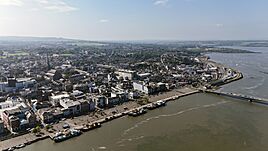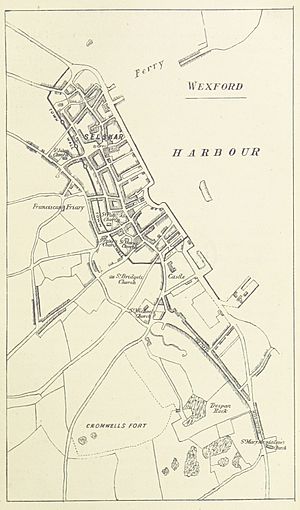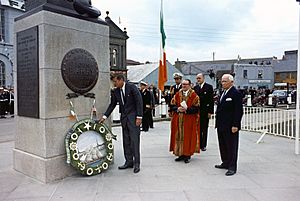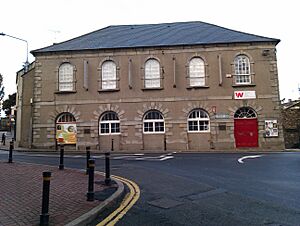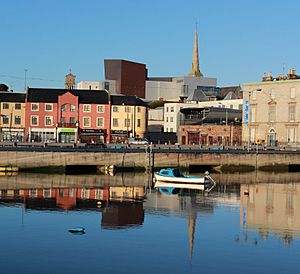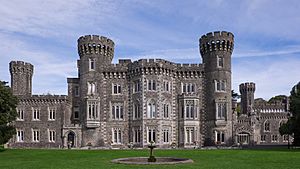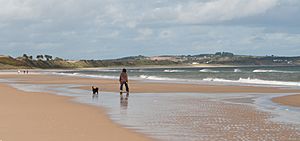Wexford facts for kids
Quick facts for kids
Wexford
Loch Garman (Irish)
|
||
|---|---|---|
|
Town
|
||
|
|
||
|
||
| Motto(s):
Per Aquam et Ignem
'Through Water and Fire' |
||
| Country | Ireland | |
| Province | Leinster | |
| County | County Wexford | |
| Elevation | 1 m (3 ft) | |
| Population
(2022)
|
21,524 | |
| Time zone | UTC±0 (WET) | |
| • Summer (DST) | UTC+1 (IST) | |
| Eircode routing key |
Y35
|
|
| Telephone area code | +353(0)53 | |
| Irish Grid Reference | T051213 | |
Wexford is a historic town located in County Wexford, Ireland. It sits on the south side of Wexford Harbour, which is where the River Slaney meets the sea. This town is in the southeast corner of Ireland.
Wexford is connected to other major Irish cities like Dublin, Cork, and Waterford by important roads. You can also travel by train to Dublin and Rosslare Europort. In 2022, about 21,524 people lived in Wexford. Its Irish name, Loch Garman, means "Garman's Lake."
Contents
- Wexford's Past: A Journey Through Time
- Wexford's Lively Culture and Arts
- Wexford's Buildings and Design
- Wexford's Economy: How the Town Works
- Fun Places to Visit in Wexford
- Getting Around Wexford: Transport Options
- Sports in Wexford
- Learning in Wexford: Schools
- How Wexford is Governed
- Famous People from Wexford
- Wexford's Twin Towns
- Images for kids
- See also
Wexford's Past: A Journey Through Time
How Wexford Began: The Vikings Arrive
Wexford was first settled by the Vikings around 800 AD. They called it Veisafjǫrðr, which means "inlet of the mudflats." This name later changed to "Wexford." For hundreds of years, Wexford was a Viking town, almost like its own small country. It was mostly independent from the Irish kings.
Norman Invasion and Changes
In 1169, Dermot MacMurrough, an Irish king, and his Norman friend Robert Fitz-Stephen attacked Wexford. The Viking people fought hard, but eventually, they agreed to a peace deal. After this, Wexford became an "Old English" settlement, meaning people from England settled there.
For a long time, a language called Yola was spoken in Wexford. It was a mix of English and other European languages. Even though Yola is no longer spoken, some words and place names from it are still used today.
Knights Templar and Early Charters
The Knights Templar, a famous group of medieval knights, also had a presence in Wexford. You can still see their name in St. John's Cemetery. Wexford received its first official town charter in 1318, giving it special rights.
Wexford During the Wars
In the 1640s, Wexford supported Confederate Ireland, a group of Irish Catholics. A fleet of privateer ships (like legal pirates) was based in Wexford. These ships attacked English Parliamentarian vessels. Because of this, the English Parliamentarians, led by Oliver Cromwell, attacked Wexford in 1649. Many people were killed, and much of the town was burned.
The 1798 Rebellion
County Wexford was a key place during the Irish Rebellion of 1798 against British rule. The town of Wexford was taken over by the Society of United Irishmen, who were fighting for Irish independence. There were sad events during this time, including violence on both sides.
Important Figures in Wexford's History
Redmond Square in Wexford is named after John Edward Redmond (1806–1865), a politician who loved Wexford deeply. His family continued to be important in Irish politics. His nephew, William Archer Redmond (1825–1880), and his grand-nephew, John Redmond, were also Members of Parliament. John Redmond led the Irish Parliamentary Party until 1918.
Redmond Park was opened in 1931 to honor Willie Redmond, who died fighting in World War I.
Wexford's Lively Culture and Arts
Wexford Opera Festival
Every October, Wexford hosts the famous Wexford Opera Festival. It started in 1951 and has grown into a big event. Sometimes, there's even a fireworks display to celebrate!
Music and Theatre Venues
Wexford has many places for music and drama:
- The National Opera House is a modern opera house built where an old theatre used to be.
- The Dun Mhuire Theatre hosts local theatre groups and music events.
- The Wexford Arts Centre has art shows, plays, music, and dance performances.
- St Iberius' Church (Church of Ireland) is also used for concerts.
Wexford is home to several theatre groups, including the Buí Bolg Street Theatre Company, known for its lively street performances. In 2024, Wexford hosted the Fleadh Cheoil, a big festival of traditional Irish music.
Wexford's Buildings and Design
Churches and Architecture
Wexford has several interesting churches. The "twin churches" on Bride Street and Rowe Street are famous for their tall spires. St Iberius' Church is an older church from the 1700s. Saint Peter's College has a chapel designed by the famous architect Augustus Welby Pugin.
Modern Developments
In recent years, Wexford has updated its waterfront area, making it a nicer place for people to enjoy. New homes have also been built in Clonard village.
Wexford's Economy: How the Town Works
The Port's History and Change
Wexford used to be a very busy seaport. However, the sand in Wexford Harbour kept shifting, making it hard for large ships to enter. Because of this, the port closed in 1968. Coal was a major import, and farm machinery and grain were exported.
Today, a new, deeper port called Rosslare Europort is located about 20 kilometers south of Wexford. All big ships now use this port, and Wexford Port is mainly for fishing boats and leisure vessels.
Local Businesses and Jobs
Johnstown Castle, just outside Wexford, is an important center for agriculture and environmental protection. Many companies have offices and factories in Wexford, providing jobs for local people. These include Wexford Creamery, Celtic Linen, and technology companies like Waters Technology and Equifax. Coca-Cola also has a research plant here.
Fun Places to Visit in Wexford
Beaches and Heritage
- Curracloe Beach, about 10 kilometers north of Wexford, is a beautiful sandy beach. It was even used for filming scenes in the movie Saving Private Ryan.
- The Irish National Heritage Park at Ferrycarrig lets you explore 9,000 years of Irish history. You can see recreated ancient Irish homes, Viking houses, and Norman forts.
Nature and Wildlife
- The Wexford Wildfowl Reserve is a special nature area just outside town. It's a stop-off point for thousands of migrating birds like ducks, geese, and swans. Many Greenland white-fronted geese spend their winter here. There's a visitor center where you can learn more about the birds.
Getting Around Wexford: Transport Options
Wexford.jpg|600px|A panorama of Wexford town.
Train Travel
Wexford O'Hanrahan railway station opened in 1872. It was renamed in 1966 after Michael O'Hanrahan, a leader in the 1916 Easter Rising. The train line connects Wexford to Dublin and Rosslare Europort.
Bus Services
Wexford has local and national bus services, including Bus Éireann and Wexford Bus. You can take direct buses to Dublin, Carlow, and Waterford. Wexford Bus also has a shuttle service around the town.
Ferry and Air Travel
Rosslare Europort is about 19 kilometers south of Wexford. From here, you can take car ferries to Wales and France. The closest airport with commercial flights is Dublin Airport, about two hours away.
Sports in Wexford
Football (Soccer)
Wexford Football Club joined the League of Ireland in 2007. They even won the League of Ireland First Division in 2015. The club also has a women's team called Wexford Youths WFC.
Gaelic Games
Wexford is home to several Gaelic Athletic Association (GAA) clubs. While the town was traditionally known for Gaelic football, hurling became very popular after Oliver "Hopper" McGrath helped the county team win the All-Ireland Hurling Final in 1960.
The St. Johns Volunteers Gaelic football club has won many county titles. In hurling, the Faythe Harriers club has also won many championships.
Other Sports
Wexford has a golf club and a rugby club, Wexford Wanderers RFC. Famous boxer and coach Billy Walsh is from Wexford and is linked to a local boxing club.
Learning in Wexford: Schools
Wexford has five secondary schools for students: Wexford CBS, Loreto Secondary School (for girls), St Peter's College (for boys), Presentation Secondary School (for girls), and The Vocational College/Selskar College (mixed).
How Wexford is Governed
Wexford used to have its own borough council. In 2014, this council joined with Wexford County Council. However, Wexford still keeps the title of a "borough," and the head of the local district is called the mayor.
Wexford has been represented in the Irish and UK parliaments for a long time. Today, it is part of the Wexford Dáil constituency.
Famous People from Wexford
- John Banville, writer
- Eoin Colfer, writer (known for Artemis Fowl)
- Kevin Doyle, footballer
- Jane Elgee 'Speranza', mother of Oscar Wilde
- Brendan Howlin, politician
- Rianna Jarrett, footballer
- Larry Kirwan, writer and musician
- Michael Londra, singer
- Declan Lowney, director
- Dan O'Herlihy, Oscar-nominated actor
- Chris O'Neill (Oney), animator and internet personality
- Billy Roche, playwright
- Declan Sinnott, musician
- Pierce Turner, singer-songwriter
- Billy Walsh, boxer and coach
- Cry Before Dawn, 1980s rock band
Wexford's Twin Towns
Wexford is "twinned" with other towns around the world, which means they have special friendly relationships:
Images for kids
See also
 In Spanish: Wexford para niños
In Spanish: Wexford para niños


